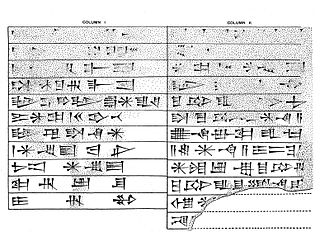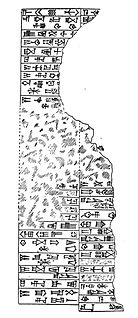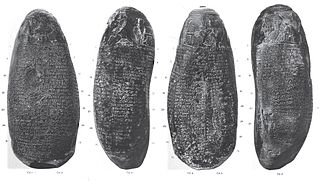 W
WA kudurru was a type of stone document used as a boundary stone and as a record of land grants to vassals by the Kassites in ancient Babylonia between the 16th and 12th centuries BCE. The word is Akkadian for "frontier" or "boundary". The kudurrus are the only surviving artworks for the period of Kassite rule in Babylonia, with examples in the Louvre, the British Museum, and the National Museum of Iraq.
 W
WIštaran was the local deity of the city of Der, a Sumerian city state positioned east of the Tigris on the border between Sumer and Elam. His cult flourished from the Early Dynastic III Period until the Middle Babylonian Period, after which his name is no longer attested in the personal names of individuals. The beast and symbol of Ištaran, as frequently represented on kudurrus, is a snake. The infrequently attested consort of Ištaran was known simply as Šarrat-Deri: "the queen of Der." In some sources, his wife was Manzat, the deification of the rainbow.
 W
WThe Blau Monuments are a pair of inscribed stone objects from Mesopotamia now in the British Museum. They are commonly thought to be a form of ancient kudurru.
 W
WThe Enlil-bānī land grant kudurru is an ancient Mesopotamian narû ša ḫaṣbi, or clay stele, recording the confirmation of a beneficial grant of land by Kassite king Kadašman-Enlil I or Kadašman-Enlil II to one of his officials. It is actually a terra-cotta cone, extant with a duplicate, the orientation of whose inscription, perpendicular to the direction of the cone, in two columns and with the top facing the point, indicates it was to be erected upright,, like other entitlement documents of the period.
 W
WThe estate of Takil-ana-ilīšu kudurru is an ancient Mesopotamian white limestone narû, or entitlement stela, dating from the latter part of the Kassite era which gives a history of the litigation concerning a contested inheritance over three generations or more than forty years. It describes a patrimonial redemption, or "lineage claim," and provides a great deal of information concerning inheritance during the late Bronze Age. It is identified by its colophon, asumittu annītu garbarê šalati kanīk dīnim, “this stela is a copy of three sealed documents with (royal) edicts” and records the legal judgments made in three successive reigns of the kings, Adad-šuma-iddina, Adad-šuma-uṣur and Meli-Šipak. It is a contemporary text which confirms the sequence of these Kassite monarchs given on the Babylonian king list and provides the best evidence that the first of these was unlikely to have been merely an Assyrian appointee during their recent hegemony over Babylonia by Tukulti-Ninurta I, as his judgments were honored by the later kings.
 W
WThe Kudurru for Šitti-Marduk is a white limestone boundary stone (Kudurru) of Nebuchadrezzar I, a king of the 2nd Dynasty of Isin, ca. the late 12th century BC. He is known to have made at least four kudurru boundary stones.
 W
WThe Kudurru of Gula is a boundary stone (Kudurru) for the Babylonian goddess Gula. Gula is the goddess of healing. It is from the 14th century - 13th century BC Kassite Babylonia, and is located at the Louvre.
 W
WThe kudurru of Kaštiliašu' is a fragment of an ancient Mesopotamian narû, or entitlement stele, recording the legal action taken by Kassite king Kaštiliašu IV over land originally granted by his forebear Kurigalzu II, son of Burna-Buriaš II to Uzub-Šiḫu or -Šipak in grateful recognition of his efforts in the war against Assyria under its king, Enlil-nirari. Along with the Tablet of Akaptaḫa, these are the only extant kudurrus from this king’s short eight-year reign and were both recovered from Elamite Susa, where they had been taken in antiquity, during the French excavations under Jacques de Morgan at the end of the nineteenth century and now reside in the Musée du Louvre.
 W
WThe Kudurrus of Isin, king Marduk-nadin-ahhe, late 2nd millennium BC, c. 1099-1082 BC.
 W
WThe land grant to Ḫasardu kudurru, is a four-sided limestone narû, or memorial stele, from the late 2nd millennium BC Mesopotamia recording the gift of 144 hectares of land on the bank of the Royal Canal in the Bīt-Pir’i-Amurru region of the Diyala valley by Kassite monarch Meli-Šipak to an official or sukkal mu’irri, by the name of Ḫa-SAR-du. It is titled, “O Adad, the hero, bestow irrigation ditches of abundance here!" and is notable for the light it sheds on middle Babylonian officialdom.
 W
WThe Land grant to Ḫunnubat-Nanaya kudurru is an ancient Mesopotamian entitlement narû recording the gift of forty GUR of uncultivated land and control over three settlements by Kassite king Meli-Šipak to his daughter and the provision of exemptions from service and taxation to villages in the region guaranteed with a sealed tablet given to her, presumably to make the land transfer more palatable to the local population. It was excavated by a French archaeological team under the auspices of Jacques de Morgan at the turn of the twentieth century at Susa where it was found with a duplicate. It had been taken as booty by Elamite king Šutruk-Naḫḫunte after his 1158 BC campaign that brought about the demise of the regime of Babylonian king Zababa-šuma-iddina, the penultimate monarch of the Kassite dynasty. It is significant in that it shows the king making a second bequest with land he purchased to provide for his beneficiary, contradicting the earlier view of Kassite feudalism, where all land belonged to the monarch.
 W
WThe Land grant to Marduk-apla-iddina kudurru is a grey limestone 0.7-meter tall ancient Mesopotamian narû or entitlement stele recording the gift of four tracts of cultivated land with settlements totaling 84 GUR 160 qa by Kassite king of Babylon, Meli-Šipak, to a person described as his servant named Marduk-apla-iddina, who may be his son and/or successor or alternatively another homonymous individual. The large size of the grant together with the generous freedom from all territorial obligations has led historians to assume he was the prince. There are thirty six kudurrus which are placed on the basis of art-history to Meli-Šipak's reign, of which eight are specifically identified by his name. This is the best preserved of all of them.
 W
WThe Land grant to Marduk-zākir-šumi kudurru is an ancient Mesopotamian narû, or entitlement stele, recording the gift (irīmšu) of 18 bur 2 eše of corn-land by Kassite king of Babylon Marduk-apla-iddina I to his bēl pīḫati, or a provincial official. The monument is significant in part because it shows the continuation of royal patronage in Babylonia during a period when most of the near East was beset by collapse and confusion, and in part due to the lengthy genealogy of the beneficiary, which links him to his illustrious ancestors.
 W
WThe Land grant to Munnabittu kudurru is an elongated egg-shaped black limestone ancient Mesopotamian narû or entitlement stele (kudurru), 46.5 cm high and 20.5 cm wide, which details the reconfirmation of a gift of 30 GUR of land by Kassite king Marduk-apla-iddina I to his servant Munnabittu, son of Ṭābu-melû. It is significant because, in addition to portraying eighteen divine icons around its top, it lists forty-seven gods in its inscription, more than any other similar object.
 W
WThe Nazimaruttash kudurru stone is a boundary stone (kudurru) of Nazimaruttaš, a Kassite king of Babylon, c. 1307–1282 BC. It was found at Susa and is now displayed at the Louvre.
 W
WThe Stele of Meli-Šipak is an ancient Mesopotamian fragment of the bottom part of a large rectangular stone edifice engraved with reliefs and the remains of Akkadian and Elamite inscriptions. It was taken as spoil of war by Elamite king Šutruk-Naḫḫunte I during his invasion of Babylonia which deposed Kassite king Zababa-šuma-iddina. It was one of the objects found at Susa between 1900 and 1904 by the French excavation team under Jacques de Morgan that seems to have formed part of an ancient Museum of trophies, or ex-voto offerings to the deity Inšušinak, in a courtyard adjacent to the main temple.
 W
WThe tablet of Akaptaḫa, or Agaptaḫa, is an ancient Mesopotamian private commemorative inscription on stone of the donation of a 10 GUR field by Kassite king Kaštiliašu IV to a fugitive leatherworker from Assyrian-occupied Ḫanigalbat in grateful recognition of his services provisioning the Babylonian army with bridles.